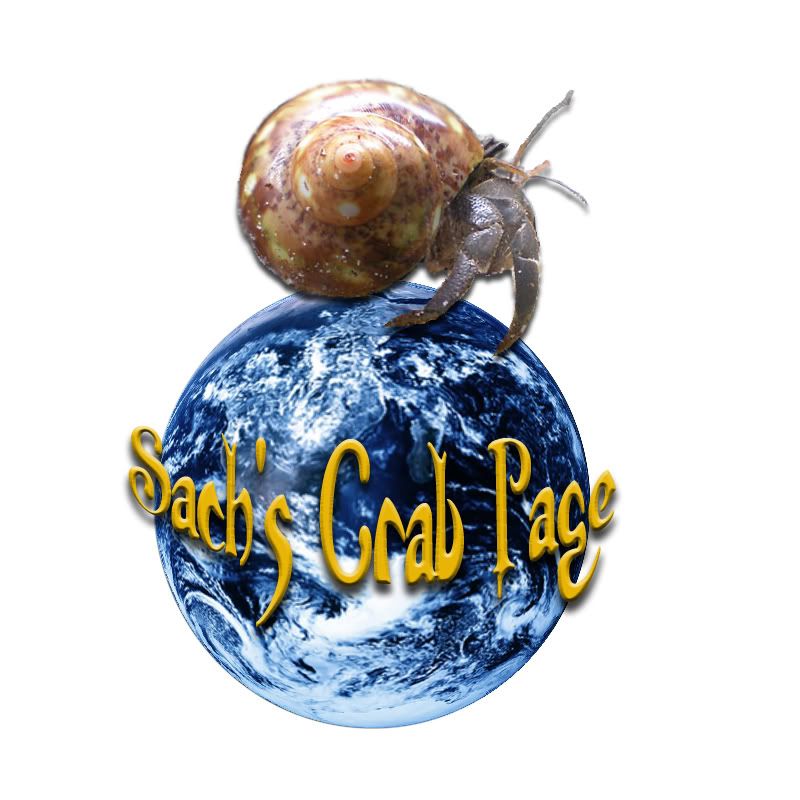Top 10 Things That Stress Hermit Crabs
Jan 21, 2013 13:50:54 GMT -5
aussieJJDude, ifluctuate, and 1 more like this
Post by Sach-Crabministrator on Jan 21, 2013 13:50:54 GMT -5
Our pet land hermit crabs (Coenobita) are often easily stressed. This is especially true of young crabs & crabs new to captivity. Stress can be fatal for our crabs. Now, those among you who know a bit more about hermit crabs may be asking yourself, "How can this be true of a species that's been around at least 5 million years?!" Well, the obvious answer is that Coenobita is very adaptable. But if you measured all of Earth's time as a week from Sunday to Saturday, the hermit crabs' time on Earth would be at about 11:59 PM on Saturday night and their time as captive pets at about 11:59:59:30 on Saturday night 
Some of the top stressors of captive hermit crabs are:
1-Over-handling by us.*
2-Poor handling during capture, transfer, sale, etc. -This is often referred to as "PPS" or "pre/post purchase syndrome/symptoms.*
3-Sub-standard conditions (this is a big one in captivity)*
4-Loneliness/boredom*
5-Dramatic change*
6-Threat*
7-Health issues*
8-Shell availability*
9-Mites*
10-Disruption during a molt*
*1-For most of our crabs, their only experience with humans were the people who grabbed them out of their homes by force & sent them off to be sold. We are HUGE to them and with their multi-faceted vision, every movement by us may seem like a threat to them. When we pick them up or put them on a cold table or cardboard box so we can get video of them, we can stress them. Bathing our crabs (as opposed to providing a way for them to do it themselves) is another big way to stress them. Thanks to my daughter for reminding me to include not spraying crabs directly with water.
*2-Most harvesters of hermit crabs destined for the pet trade literally go out at night & just snatch them up. They toss them rudely in buckets or bags and then often put them in big cement warehouse rooms (or worse) before either crowding them into shipping crates (if they are lucky) or bags and sending them off to pet suppliers with no thought to their temperatures or humidity needs. They then end up at pet stores where, let's be honest 98% of the time the conditions are horrid, the food is toxic & there is no real care. This doesn't even scratch the surface of what happens to crabs who are slated to be sold in painted shells as they are forcibly removed from their natural shells.
*3-If conditions (proper substrate, temperature, humidity, company, etc) aren't ideal for molting (the way our crabs grow) then they will actually delay growing until conditions improve. The problem is that if they have to put it off for too long, they die. If the conditions are too dry, they can't breathe. If conditions are too cold, they go into a stasis-type condition. If conditions are too hot, they may abandon their shell & overheat & die. If conditions are crowded, they may be bullied, lose out on food or shells or even be dug up during a molt. They may not even have a place to molt (or shells) if your tank is over-crowded. The main reason why this is an issue in captivity is because if conditions in the wild aren't good; said crab will move on to where they ARE. In captivity, they don't have this option.
*4-In the wild, hermit crabs live in huge colonies; often consisting of several blood-family groups or "adopted" family groups numbering in the hundreds. It is literally instinctual for older crabs to "teach" younger crabs about everything from where the good food is, to the best trees to climb. They are a VERY social species and can get upset to the point of stressed death if they are alone. The same is true if they have a major lack of stimulation (things to climb, dig, explore, etc) in their captive habitat.
*5-Dramatic changes in your tank like substrate change or replacement, major work, etc can be disruptive & therefore cause stress. Hermit crabs rely heavily on smell & visual recognition. You mess with their home too much and too often and you can stress them. In a well-maintained crabitat, substrate changes are unnecessary and disrupt the natural microorganisms in the tank as well as molt caves since most crabs like having their own burrows they can return to over & over again.
*6-Crabs can be stressed from being threatened in many ways. This can be anything from us humans reaching in to grab them too often to feeling threatened by other crabs in an over-crowded or under-nourished tank. Some crabs also will feel threatened if they can't fully retract into a proper-sized shell or if your cat is constantly jumping on the tank (for example). This also includes post-molt attacks by other crabs.
*7-If a crab has a health issue such as a missing limb or being under nourished, this can cause stress. Molting is very stressful as well so they should be left alone during this time so as to not add stress to an already stressful situation. This includes providing extra calcium & protein for their tankmates so they don't get tempted to dig up the molter.
*8-Research has shown that crabs don't grow as big or as fast if there aren't proper sized shells available for them to move into as they grow. This means that your crab will not only be stressed from not having the right shells, but will add the stress of delaying molts.
*9-Pet store crabs often have small mites when they are brought in from the wild. These little pests crawling all over our crabs can stress them. Note that mites are very rarely found on PPs or compressus.
*10-Crabs should NEVER be disturbed during a molt; either by us or other crabs. All of their energy is put into the process of molting & when they first get out of their exoskeleton they are very weak & have poor control of their soft limbs so would easily feel threatened by being bothered.
This is by no means an exhaustive list as some crabs are just more or less sensitive than others and every crabber will have a unique experience.

Some of the top stressors of captive hermit crabs are:
1-Over-handling by us.*
2-Poor handling during capture, transfer, sale, etc. -This is often referred to as "PPS" or "pre/post purchase syndrome/symptoms.*
3-Sub-standard conditions (this is a big one in captivity)*
4-Loneliness/boredom*
5-Dramatic change*
6-Threat*
7-Health issues*
8-Shell availability*
9-Mites*
10-Disruption during a molt*
*1-For most of our crabs, their only experience with humans were the people who grabbed them out of their homes by force & sent them off to be sold. We are HUGE to them and with their multi-faceted vision, every movement by us may seem like a threat to them. When we pick them up or put them on a cold table or cardboard box so we can get video of them, we can stress them. Bathing our crabs (as opposed to providing a way for them to do it themselves) is another big way to stress them. Thanks to my daughter for reminding me to include not spraying crabs directly with water.
*2-Most harvesters of hermit crabs destined for the pet trade literally go out at night & just snatch them up. They toss them rudely in buckets or bags and then often put them in big cement warehouse rooms (or worse) before either crowding them into shipping crates (if they are lucky) or bags and sending them off to pet suppliers with no thought to their temperatures or humidity needs. They then end up at pet stores where, let's be honest 98% of the time the conditions are horrid, the food is toxic & there is no real care. This doesn't even scratch the surface of what happens to crabs who are slated to be sold in painted shells as they are forcibly removed from their natural shells.
*3-If conditions (proper substrate, temperature, humidity, company, etc) aren't ideal for molting (the way our crabs grow) then they will actually delay growing until conditions improve. The problem is that if they have to put it off for too long, they die. If the conditions are too dry, they can't breathe. If conditions are too cold, they go into a stasis-type condition. If conditions are too hot, they may abandon their shell & overheat & die. If conditions are crowded, they may be bullied, lose out on food or shells or even be dug up during a molt. They may not even have a place to molt (or shells) if your tank is over-crowded. The main reason why this is an issue in captivity is because if conditions in the wild aren't good; said crab will move on to where they ARE. In captivity, they don't have this option.
*4-In the wild, hermit crabs live in huge colonies; often consisting of several blood-family groups or "adopted" family groups numbering in the hundreds. It is literally instinctual for older crabs to "teach" younger crabs about everything from where the good food is, to the best trees to climb. They are a VERY social species and can get upset to the point of stressed death if they are alone. The same is true if they have a major lack of stimulation (things to climb, dig, explore, etc) in their captive habitat.
*5-Dramatic changes in your tank like substrate change or replacement, major work, etc can be disruptive & therefore cause stress. Hermit crabs rely heavily on smell & visual recognition. You mess with their home too much and too often and you can stress them. In a well-maintained crabitat, substrate changes are unnecessary and disrupt the natural microorganisms in the tank as well as molt caves since most crabs like having their own burrows they can return to over & over again.
*6-Crabs can be stressed from being threatened in many ways. This can be anything from us humans reaching in to grab them too often to feeling threatened by other crabs in an over-crowded or under-nourished tank. Some crabs also will feel threatened if they can't fully retract into a proper-sized shell or if your cat is constantly jumping on the tank (for example). This also includes post-molt attacks by other crabs.
*7-If a crab has a health issue such as a missing limb or being under nourished, this can cause stress. Molting is very stressful as well so they should be left alone during this time so as to not add stress to an already stressful situation. This includes providing extra calcium & protein for their tankmates so they don't get tempted to dig up the molter.
*8-Research has shown that crabs don't grow as big or as fast if there aren't proper sized shells available for them to move into as they grow. This means that your crab will not only be stressed from not having the right shells, but will add the stress of delaying molts.
*9-Pet store crabs often have small mites when they are brought in from the wild. These little pests crawling all over our crabs can stress them. Note that mites are very rarely found on PPs or compressus.
*10-Crabs should NEVER be disturbed during a molt; either by us or other crabs. All of their energy is put into the process of molting & when they first get out of their exoskeleton they are very weak & have poor control of their soft limbs so would easily feel threatened by being bothered.
This is by no means an exhaustive list as some crabs are just more or less sensitive than others and every crabber will have a unique experience.








 hahahha
hahahha
